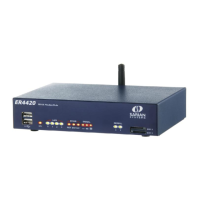Firewall configuration
Digi TransPort User Guide 663
An ip-object can also be specified using an address mask. This is a way of describing which bits of
the IP address are relevant when matching. The script processor supports two formats for
specifying masks.
• Method 1: The IP address is followed by a forward slash and a decimal number. The decimal
number specifies the number of significant bits in the IP address. For example, if you wanted
to block all packets in the range 10.1.2.* the rule would be:
block from any to 10.1.2.0/24
such as, only the first 24 bits of the address are significant.
• Method 2: This same rule could be described another way using the mask keyword:
block from any to 10.1.2.0 mask 255.255.255.0
The IP address can also contain either addr-ppp n or addr-eth n, where n is the eth or ppp
instance number. In this case, the rule specifies that the IP address is that allocated to the PPP
interface or to the Ethernet interface. This is useful when IP addresses are obtained automatically
and therefore are not known by the author of the filtering rules. For example:
block in break end on ppp 0 from addr-eth 0 to any
Address/Port translation
One further option for specifying addresses is to use address translation. The syntax for this is:
srcdst = “all | fromto [-> [ip-object] “to” object]
such as, directly after the IP addresses and port are specified an optional
-> can follow,
indicating that the addresses/ports should be translated. The first source object is optional, and is
unlikely to be used, as it is more normal to translate the destination address.
The following example reroutes packets originally destined for 10.10.10.12 to 10.1.2.3:
pass out break end from any to 10.10.10.12 -> to 10.1.2.3
In addition, complete subnets can have NAT applied. The address bits not covered by the subnet
mask are taken from the original IP address. For example, to NAT the destination subnet of
192.168.0.0/24 to be 192.168.1.0/24, the firewall rule is:
pass out break end from any to 192.168.0.0/24 -> to 192.168.1.0/24

